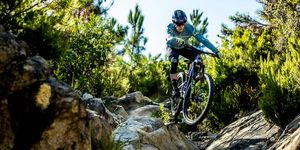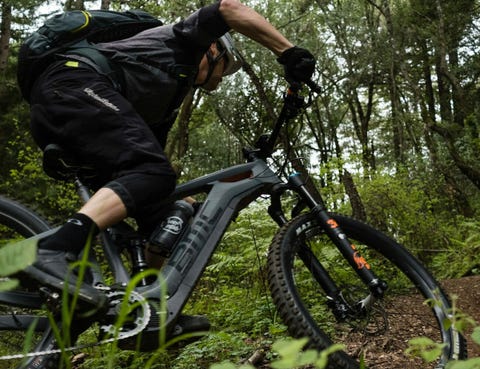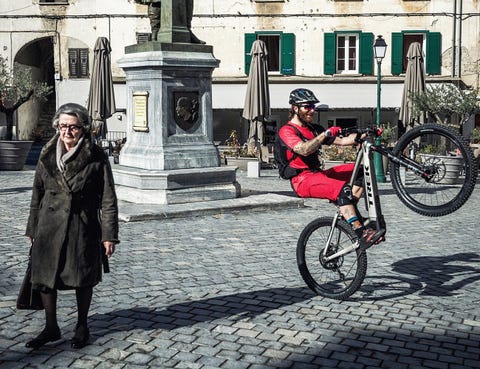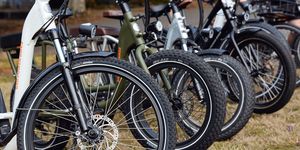There was a time when mountain bikers were the “drunk uncle” at the outdoor buffet: socially awkward, irreverent, “too noisy, too fast” outcasts on the dusty lam. Hikers called them out for harshing the trail’s mellow. Conservationists pegged bikes as trail wreckers. Decades later, the once rogue group of trail punks has grown up — wiser, savvier and more organized. The International Mountain Biking Association (IMBA) has emptied countless tubs of elbow grease advocating for social and physical space on the trails to ensure we have places to ride.
But here we are again. Same story, new bikes. This time weighing the validity of electric-assist bikes on the very same trail systems. The most hesitant to accept electric-assist mountain bikes? Their own breed, mountain bikers.
If electric-assist mountain bikes (e-MTBs) are new to you, at face value, they’re pretty much what you’d think. A mountain bike pimped with a battery pack and motor, boosting one’s pedal stroke up to 750 watts (capped by a governor). In the States, there are three classifications of e-bikes. (A fourth class exists, but e-bikes capable of speeds above 28 mph pushing out over 750 watts of power are considered a moped/motorcycle).
Class 1: Pedal-assist motor that boosts your pedal speed, but caps at 20 mph.
Class 2: Throttle-assist that can accelerate the bike up to 20 mph without pedaling.
Class 3: Pedal-assist bike that caps your throttle speed at 28 mph.
The parsing of power aside, e-bikes have a motor, and indisputably put e-MTBs in the motorized space — a space mountain bikers lobbied hard to distance themselves from some 30 years ago when they successfully splintered mechanized from motorized transportation on managed land.
And it all harkens back to legislation passed in 1964.
The original draft of the Wilderness Act was signed by President Lyndon B. Johnson to preserve wild land as untrammeled by man and “motorized transport.” Mind you, this was ten years before the Marin County crew squeezed ballooning tires under their klunkers — fat tires were nowhere near the map. But once they were, riders were pedaling off into miles of wild terrain, out onto wilderness trails, and into confrontations with, well, everyone else.
Congress banned bikes in wilderness areas in 1977. But 1984 marked the boiling point on managed land when the travel classification was revisited and “motorized” was rolled back to include all “mechanized” transportation. For the first time, mountain bikes were legally tagged as outliers. The change in stature drew a line in the dirt, and local land managers followed suit, lumping bikes with motorized vehicles on non-wilderness trails. It took heaps of advocacy and stacks of environmental studies, but the IMBA steadily wrestled mountain bikes back onto many of our local trails.
But now comes along a motor. Neither a bike nor a motorcycle. For some, the two-wheeled electric-assist mountain bikes fall in that head-scratching space reserved for the duck-billed platypus. Naysayers denounce the Johnny-come-lately, waxing on about cheating, Strava doping, trail destruction and reckless riding. If this resonates, you’re not the target audience.
“You gotta remember how happy you were when you were introduced to mountain biking for the first time,” shares Sam Benedict, global category leader at Specialized. “But let’s not be ‘that sport.’ Getting people out on the trails is a good thing!”
The industry sees e-MTBs as a leveler, enabling people of disparate ages and abilities to ride together. The assist lures otherwise wary riders into a sport perceived as “too hard.” The biggest proponents of e-MTBs? Resorts. A pedal full of watts lets flatlanders level up quickly at altitude. No surprise — the e-MTB offers the potential for more summer visitors and an increased bottom line during the skiing off-season.
And e-bikes are the fastest growing sector in the bike market — an industry that was valued at over $800 million in 2017, and has a predicted 6% growth each year through at least 2025. With brands big and small getting in the game, a flood of e-bikes is hitting the market, and creating a whole new class of mountain bikers. You might think all these new riders would equate to more power through voices in trail advocacy and be welcomed with open arms by IMBA, who’ve tirelessly worked to educate the public about mountain bikes and preserve trail space. The reality has been a more cautious, steadily evolving approach.
"As the new fastest user group on non-motorized trails, the addition of e-MTBs to an already crowded, shared-use trail landscape has caused the user conflicts we could all predict. While we all know conflicts stem from a few bad actors, these challenges have been the spark for a renewed approach to trail etiquette. Not just for e-MTBs, but for all trail users," IMBA executive director David Wiens wrote in an op/ed for Bicycle Retailer last month. "IMBA emphasizes responsible Class 1 e-MTB riding through our work with Trails are Common Ground, a movement we helped catalyze to improve the experience of all trail users. We united expertise from hiking, trail running, equestrian use, mountain biking, adaptive riding, and motorized use to form the Trails are Common Ground coalition."
This statement represents a big step forward from a few years ago, when Wiens stated: "First and foremost, we advocate for access for traditional, non-motorized mountain bikes. IMBA does not advocate for access for e-MTBs." And Trails are Common Ground is worth checking out, as it features a number of guides related covering the different classes of e-bikes and where you can ride them.
Where does the government stand? National parks, BLM and U.S. Fish and Wildlife Service generally permit e-bikes to go where other MTBs go, unless local administrators step in and issue additional specific advisories. The U.S. Forest Service rolled out new guidelines last year, allowing all e-bikes on motorized roads and trails, opening up 38% of all trails with more to come, potentially. But it's often up to local jurisdictions. Pedaling in Delaware, an e-MTB is considered a bike. In Alabama? It’s a motorized bike. To say the least, riding an e-bike is … messy.
So what’s it going to take to enter the circle of trust? For Larry Pizzi, general manager at Alta Cycling Group and chairman of the e-bike subcommittee at People for Bikes, an industry coalition of bicycle suppliers and retailers, it’s going to take small wins. “It starts with classification, otherwise people will default to the worse case,” Pizzi says. The acceptance of distinct classes (armed with data) helped the IMBA have a change of heart, and accept Class 1 e-MTBs on trails.
“Next, we need to demystify the e-bike and get demos in the hands of the land managers,” says Pizzi. “Armed with the right information, they’ll make informed decisions.” Most importantly, land managers need to see for themselves the environmental and social impact of e-MTBs.
Pizzi’s last point — and it’s a big one — is to lobby for a change in the classification of motorized to self-propelled. It’s an “if you can’t join them, reinvent yourself” approach that would pull e-MTBs away from the legal definition that’s currently keeping extra watts off managed land.
People are tribal creatures. We gravitate toward like-minded cliques that ferociously embrace imbued values. And nowhere in the outdoor world is this truer than in cycling. Perhaps no amount of physical data will sway the minds of the purist cyclists. Because in the end, it’s a social science, not a hard science.
And hey, I get it. I live in Boise — the new darling of outdoor towns, identified as the “fastest growing town in America.” My once abandoned morning trails now have (gasp!), people! People on foot, people on horses, people on bikes, people on motorcycles. And technology isn’t slowing up, it’s only gaining momentum. Technology has made stravassholes, introduced drones and now put a bit of torque in a bike.
“We need to educate, and identify,” concludes Benedict. “By working with the government and local land managers, we can classify bikes and instill trail etiquette and stewardship. Together we can draw up sustainable plans and then encourage positive behavior — and change the social perception.”
You know, teach us how to share.





















